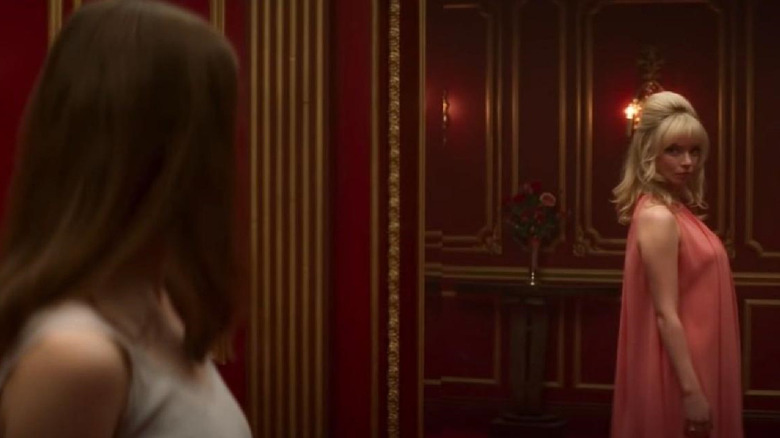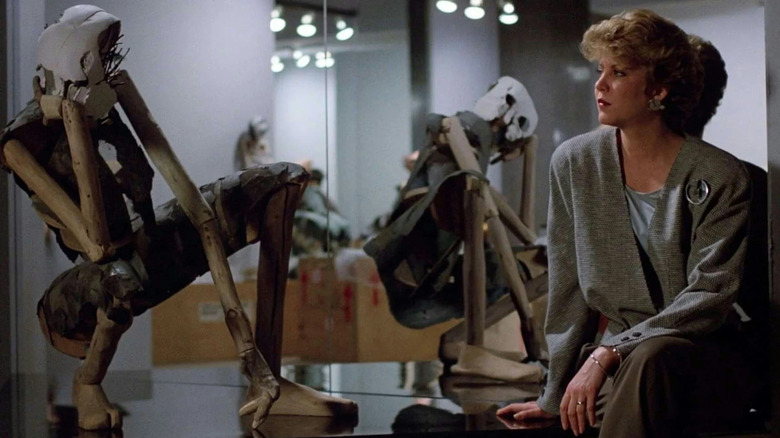How Poltergeist III Inspired Edgar Wright's Mirror Shots In Last Night In Soho
It's not everyday you get to call Gary Sherman as a creative lifeline on your project, but Edgar Wright is one of the few and the proud to get the assist from the "Vice Squad" filmmaker. Wright is enjoying the returns from his latest effort, "Last Night in Soho," which premiered on October 29. It's got a killer soundtrack and a goddess-tier performance from Diana Rigg, but notably within "Soho's" bag of tricks is a dazzling mirror shot of both its leads, Anya Taylor-Joy and Thomasin McKenzie, on opposite sides of the reflective glass. It's an impeccably-timed maneuver involving sly blocking, a double set, and identical twins to make it appear as if the two women are intimately connected over time and space.
The cinephile director cites several sources of inspiration for the mirror shots in his film, including that impossible deleted sequence in "Terminator 2: Judgment Day." But the single greatest influence, as Wright tells it to Fangoria's Michael Gingold, is the third sequel of a popular '80s horror franchise. In an exclusive interview with the genre-focused magazine, the "Baby Driver" director went long on why he wanted the mirror shots so badly in the first place — for the vibe.
I think people assume that all effects in films are achieved digitally now, but I wanted at least some of the mirror scenes to involve Thomasin and Anya actually standing opposite each other doing choreography—really sharp choreography by Jennifer White. We also designed these bits to be in long, unbroken takes, because it was important for the scenes to be immersive, in the sense that you're seeing the film through Thomasin as Eloise's eyes. I wanted the shots to reflect that as well, so we didn't break the spell; when maybe an audience would start to think, 'How the hell are they doing this?' it would be the same as Eloise saying, 'What the hell is happening?'
Conceiving of the effects are easy enough; the challenge for Wright was to pull it off convincingly, in-camera. For that, he leaned on an influence who happened to be in his contacts list. Gary Sherman's "Poltergeist III" makes use of several impressive mirror shots, like disjointed interactions between Heather O Rourke and her "reflection." In fact, most of the mortals are harassed by the spirit world through mirrors in the movie (in a skyscraper seemingly made of them), and it's all so well-executed that Wright couldn't figure the illusion out after repeat viewings. So, he fired up an email.
'It Was About as Geeky an Extended Lunch Meeting As You Could Possibly Have!'
In the chat with Fangoria, Wright breaks down the sequence of events that led to one of the most memorable cinematic character entrances of the year:
His film "Poltergeist III" is chock full of amazing mirror shots, and there were one or two where we were sitting around trying to analyze how they were done, and that we couldn't quite figure out. And I thought, 'Well, I know Gary Sherman,' so I e-mailed him and said, 'Hey, this film I'm doing has a lot of mirror shots in it. I was wondering if we could pick your brain,' and he said, 'Sure!' So one afternoon, Gary, who I just saw the other night at the L.A. premiere, did a little tutorial with our crew. It was the best extended lunch break on a Friday; it was like, 'Hey, guys, if you want to gather in the meeting room, Gary Sherman is going to talk us through the shots in "Poltergeist III!" [Laughs] It was about as geeky an extended lunch meeting as you could possibly have!
Mirrors are a recurring motif in "Soho," a choice screenwriter Krysty Wilson-Cairns intended to reflect — or refract — the fragmented psyche of its star Ellie (McKenzie). The horror mystery follows fashion student Ellie as she slips into a portal of sorts — she has visions of the swinging 1960s London, and as the visions continue she becomes obsessed with an ambitious starlet, played by Anya Taylor-Joy.
The title itself is yet another reference, to a wonderful 1968 Dave Dee, Dozy, Beaky, Mick & Tich song that Wright had a conversation over with director Quentin Tarantino (whose own ode to the 1960s, "Once Upon A Time In Hollywood," is currently available on VOD and streaming). Wright's penchant for tapping into beloved iconography pays off as well as his email to Sherman did: the introductory mirror shot, along with several other photographic sleights-of-hand, underlines Wright's status as a high-style, high-octane storyteller and more than achieves the "How the hell are they doing this?" reaction that he's looking for.

